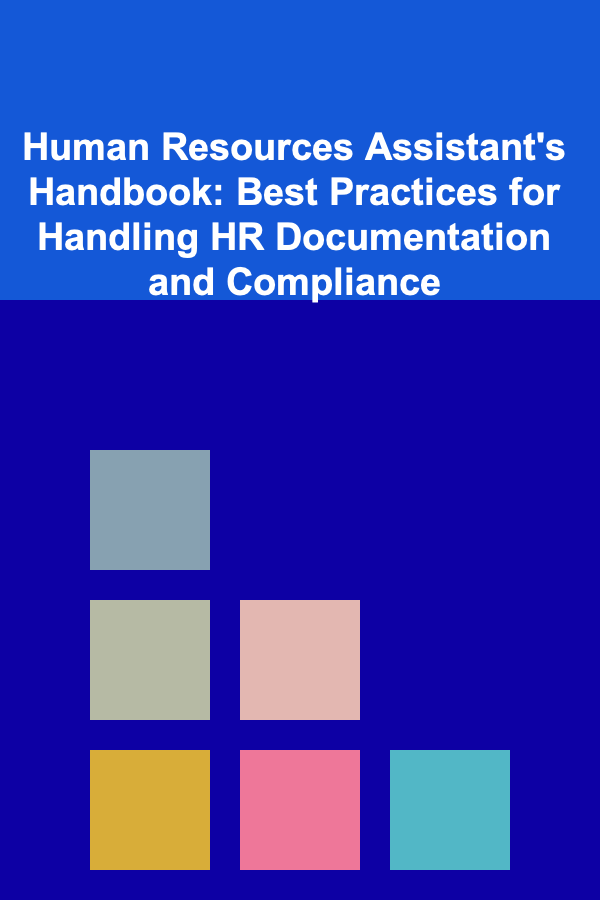
Human Resources Assistant's Handbook: Best Practices for Handling HR Documentation and Compliance
ebook include PDF & Audio bundle (Micro Guide)
$12.99$10.99
Limited Time Offer! Order within the next:

As a Human Resources (HR) Assistant, your role in managing documentation and ensuring compliance with labor laws and company policies is crucial to maintaining a smooth and legally compliant workplace. HR documentation plays a significant role in keeping track of employee information, organizational policies, and legal requirements. Adopting best practices for handling HR documentation and compliance not only helps the organization avoid legal risks but also ensures smooth day-to-day operations and enhances employee trust and satisfaction.
This comprehensive guide will delve into the best practices for handling HR documentation and compliance effectively. It will provide HR Assistants with actionable steps to stay organized, comply with legal requirements, and ensure that documentation is secure and easily accessible.
Understand the Importance of HR Documentation
HR documentation is a collection of records that detail all aspects of the employment relationship, from hiring to termination. This includes job applications, offer letters, performance reviews, tax forms, disciplinary records, and much more. Properly managing these documents ensures that the organization meets legal obligations, mitigates risks, and creates a transparent environment for employees.
Key Benefits of Proper HR Documentation:
- Legal Compliance: Maintaining accurate and up-to-date records ensures that the organization is in compliance with labor laws, tax regulations, and industry-specific requirements.
- Risk Management: Proper documentation reduces the risk of lawsuits, audits, and disputes by providing evidence that policies and procedures were followed.
- Performance Management: Detailed records of employee performance, training, and feedback help to make informed decisions about promotions, raises, or corrective actions.
- Employee Relations: Clear and accurate documentation can foster trust between employees and management, as it demonstrates transparency and consistency in decision-making.
As an HR Assistant, understanding the role of documentation in safeguarding both the employee and the organization is essential.
Maintain Organized and Secure Documentation
The key to managing HR documentation efficiently is organization and security. Properly stored records ensure that sensitive information is accessible when needed and protected from unauthorized access or loss.
Actionable Steps:
- Create a Centralized Filing System: Develop a system for organizing documents, whether digital or physical. A digital document management system (DMS) can help streamline storage and retrieval, while also reducing physical space requirements. Ensure the system allows easy categorization, such as by employee name, department, or document type.
- Use HR Software: Many HR software platforms offer secure, cloud-based storage for employee records. These platforms are designed to keep track of everything from hiring documents to performance reviews and can even assist in tracking compliance with deadlines for record retention.
- Physical Document Storage: For physical records, create a filing system that is easy to navigate. Use clearly labeled folders, categorize documents by type, and ensure that they are stored in a secure, locked area. Limit access to authorized personnel only.
- Ensure Compliance with Data Protection Laws: Protect sensitive personal information such as Social Security numbers, medical records, and pay information. Encrypt digital files, use password protection, and limit access to these documents based on need. When storing paper records, consider secure shredding or destruction practices when they are no longer needed.
- Back-Up Documents: Regularly back up digital HR records to ensure they are not lost in case of system failure. Ensure that backup processes are reliable and stored in a secure location.
Best Practices for Digital and Physical HR Documentation:
- Implementing role-based access controls.
- Regularly reviewing and updating security measures.
- Encrypting sensitive employee data both in transit and at rest.
- Having clear policies for document retention, archiving, and destruction.
Stay Compliant with Legal Requirements
Compliance with labor laws and regulations is an ongoing process that requires HR Assistants to stay updated on federal, state, and local laws. This includes understanding and adhering to employment standards, wage laws, discrimination laws, health and safety requirements, and data protection regulations.
Actionable Steps:
- Familiarize Yourself with Employment Laws: HR Assistants should stay informed about relevant labor laws, such as the Fair Labor Standards Act (FLSA), Equal Employment Opportunity (EEO) guidelines, Occupational Safety and Health Administration (OSHA) regulations, and the Family and Medical Leave Act (FMLA). Ensure that HR policies and documentation reflect these laws.
- Update Employee Handbooks and Policies: Regularly update employee handbooks and policy manuals to ensure they are in line with current laws and regulations. HR Assistants can assist in reviewing and revising these documents as needed to address changes in the law.
- Track Legal Deadlines: Certain documents, such as tax filings and compliance reports, need to be submitted within strict deadlines. Use HR software or a calendar system to track these deadlines and ensure all necessary filings are submitted on time.
- Record Retention: Be aware of the required retention periods for different types of documents. For instance, some documents, like employee tax records, must be kept for several years, while others may have shorter retention periods. Ensure that the organization complies with these retention schedules to avoid penalties.
- Be Aware of Industry-Specific Regulations: Depending on your industry, there may be additional compliance requirements. For example, healthcare organizations must adhere to the Health Insurance Portability and Accountability Act (HIPAA), while financial institutions may need to comply with specific anti-money laundering (AML) regulations.
Regular Compliance Audits:
- Regularly audit employee files and HR processes to ensure compliance.
- Work with legal advisors to ensure that changes in the law are immediately addressed within HR documentation.
- Keep up-to-date with changes in legislation that impact employment practices.
Implement a Standardized Documentation Process
A standardized process for creating, managing, and storing HR documentation ensures consistency across the organization. Whether it's for hiring, promotions, or performance management, a streamlined process can help HR Assistants stay on top of their tasks and reduce the risk of errors or omissions.
Actionable Steps:
- Standardize Document Templates: Create and use standardized templates for common HR documents such as offer letters, employee contracts, performance appraisals, and disciplinary notices. This ensures consistency and reduces the likelihood of mistakes or omissions in important legal language.
- Streamline the Onboarding Process: Develop a checklist for new hires that includes all necessary documentation, such as tax forms, contracts, benefits enrollment forms, and confidentiality agreements. Using an onboarding software platform can automate much of this process.
- Create Clear Approval Workflows: Implement a clear process for reviewing and approving documents. For example, when creating performance evaluations or disciplinary records, ensure that there are predefined steps for managers, HR staff, and executives to review and approve these documents.
- Digitize Documents When Possible: If feasible, transition paper-based processes to digital formats. Use document management tools that allow easy sharing, updating, and collaboration on HR documents. Digital records are also easier to store and retrieve, reducing the administrative burden on HR teams.
- Regular Document Review: Conduct regular reviews of documentation and procedures to ensure that all forms are up to date and in compliance with company policies and legal regulations.
Employee Privacy and Confidentiality
Employee privacy is a critical aspect of HR documentation. It is essential to ensure that sensitive employee information is handled with the utmost care and is protected from unauthorized access. Employees trust HR to maintain confidentiality, and breaching that trust can have significant consequences for both the employee and the organization.
Actionable Steps:
- Secure Handling of Sensitive Information: Employee records, including performance reviews, disciplinary actions, and medical information, must be treated with high levels of confidentiality. Limit access to these documents to those who need them to perform their job functions.
- Non-Disclosure Agreements (NDAs): Consider having employees sign non-disclosure agreements, especially in sensitive positions or industries. NDAs can further protect the confidentiality of proprietary company information and employee details.
- Confidentiality Policies: Establish clear confidentiality policies that explain the handling, storage, and sharing of sensitive employee information. Ensure that employees are trained on the importance of confidentiality and the potential consequences of violating it.
- Secure Communication: When sharing sensitive employee information, always use secure communication channels. For example, avoid emailing confidential data and consider using encrypted file sharing services for HR-related documents.
- Provide Employee Access to Their Records: In many jurisdictions, employees have the right to access their personnel records. Be transparent about this right, and provide employees with a secure and straightforward process for reviewing their files when requested.
Conclusion
Effective management of HR documentation and compliance is a core responsibility of the HR Assistant. By implementing best practices in organization, security, legal compliance, and standardization, you can ensure that your organization remains compliant with employment laws, minimizes risks, and maintains employee trust.
Staying on top of evolving laws, keeping documents secure, and maintaining a transparent and consistent process will not only streamline your day-to-day work but also contribute to the overall success of the organization. As the HR landscape continues to evolve, staying informed and proactive will position you as a valuable asset to your organization.

Building a Profitable Business with Deep Learning and AI
Read More
How to Build a Soundproof Music Studio in Your Home
Read More
How to Combat Redness and Rosacea with Skincare
Read More
How to Optimize Vertical Space in a Small Craft Area
Read More
How to Secure Your Home's Wi-Fi Network from Hackers
Read More
How to Spot and Avoid Common Security Scams
Read MoreOther Products

Building a Profitable Business with Deep Learning and AI
Read More
How to Build a Soundproof Music Studio in Your Home
Read More
How to Combat Redness and Rosacea with Skincare
Read More
How to Optimize Vertical Space in a Small Craft Area
Read More
How to Secure Your Home's Wi-Fi Network from Hackers
Read More